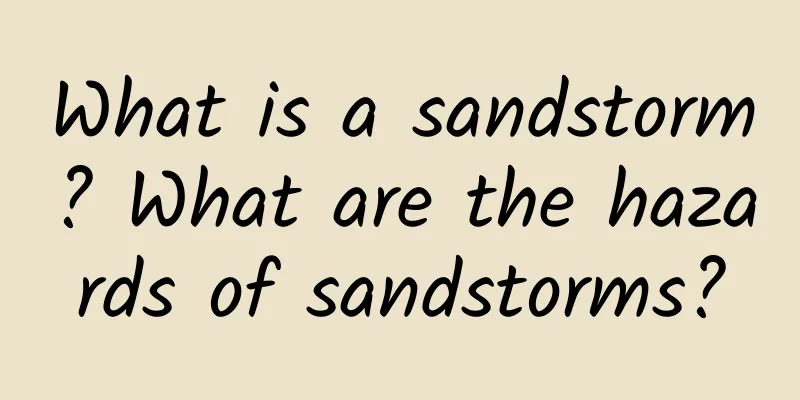What is a sandstorm? What are the hazards of sandstorms?

|
When a sandstorm occurs, floating dust is everywhere. The air in the area is turbid, causing nasal and eye problems, and the number of people suffering from respiratory diseases increases, which brings unnecessary troubles to people's health and life. What other hazards does a sandstorm have? How should people prevent and control it in normal times? Let's take a look! Contents of this article 1. What is a sandstorm? 2. What are the hazards of sandstorms? 3. How to control sandstorms 1What is a sandstorm?Dust storm is a disastrous weather phenomenon caused by the interaction of wind and sand. Its formation is inseparable from factors such as the global greenhouse effect, El Nino phenomenon, sharp decline in forests, vegetation destruction, species extinction, and abnormal climate. Among them, the over-exploitation of natural resources, excessive deforestation, and excessive land reclamation caused by population expansion are the main reasons for the frequent occurrence of sandstorms. As a high-intensity wind and sand disaster, sandstorms do not occur in all windy places. Sandstorms are only likely to occur in areas with arid climates and sparse vegetation. Exposed land can easily be blown up by strong winds to form sandstorms or even strong sandstorms. There are many hazards caused by sandstorms. 1. Death of humans and animals, collapse of buildings, and reduction of agricultural production. The harm of sandstorms to humans, animals and buildings is no less than that of typhoons and tornadoes. 2. Air pollution and topsoil loss. There are at least 38 chemical elements in the dust of sandstorms. Its occurrence greatly increases the concentration of solid pollutants in the atmosphere, causing long-term and potential harm to the atmospheric environment, soil, and agricultural production in the origin, surrounding areas, and downwind areas. In particular, after the thin topsoil on which crops depend for survival is blown away, the barren land will seriously affect the yield of crops. 2What are the hazards of sandstorms?When a sandstorm occurs, the sand and dust carried by the wind spread everywhere. The air in the area is turbid, choking and blinding, and the number of people suffering from respiratory diseases increases. Sandstorms can also cause wind erosion of the surface soil and aggravate desertification. Thick sand and dust cover the leaves of plants, affecting normal photosynthesis and causing crop yield reduction. Sandstorms can also cause a sharp drop in temperature. The sky is like a parasol, and the ground is in the shadow and becomes dark and cold. A sandstorm is a weather phenomenon in which strong winds blow up dust from the ground, making the air very turbid and the horizontal visibility less than 1 km. Sandstorms are a weather phenomenon in wind erosion and desertification, and their formation is affected by both natural factors and human activities. Natural factors include strong winds, reduced precipitation and sand sources. Human activities refer to the destruction of vegetation by humans in the process of economic development, which leads to an increase in the frequency of sandstorms. Sandstorms mainly occur in winter and spring. This is because there is little precipitation in semi-arid and arid areas in winter and spring, the surface is extremely dry and loose, and the ability to resist wind erosion is very weak. When strong winds blow, a large amount of sand and dust will be swept into the air, forming sandstorms. 3How to control sandstormsMethods for controlling sandstorms: Plant vegetation to strengthen the biological protection system against sandstorms; implement legal protection and restoration of forest and grass vegetation, prevent further expansion of land desertification, and reduce the source of sandstorms as much as possible. Dust storm is a general term for both sandstorm and dust storm. It refers to a severe sandstorm weather phenomenon in which strong winds blow a large amount of sand and dust from the ground into the air, making the air extremely turbid and the horizontal visibility less than one thousand meters. Sandstorm refers to a storm with sand in it formed by strong winds blowing a large amount of sand into the near-ground layer, while dust storm refers to a storm formed by strong winds blowing a large amount of dust and other fine particles into the high altitude. |
>>: What is a red alert for sandstorms? What should you do if a sandstorm hits the desert?
Recommend
Can I still get pregnant if I took the birth control pill within 72 hours?
More and more women do not want to get pregnant i...
Will moxibustion cause internal heat? What should I do if it causes internal heat?
Moxibustion itself is a therapy with the main pur...
Why does a woman have blood in her urine after sex?
Some women have many symptoms of discomfort after...
How to treat cervicitis
Cervicitis is a very common gynecological disease...
Chinese medicine can completely cure gynecological diseases
Women are born to pursue beauty. If they suffer f...
Can I detect pregnancy if my period is delayed for 3 days?
Can I detect pregnancy if my period is delayed fo...
When is the best time for pregnant women to take a walk?
Pregnant women should pay more attention to exerc...
How to relieve stomach pain during menstrual period in girls
Every woman has menstruation. Women who have expe...
What are the traditional Chinese medicines for promoting lactation?
Breast milk is the best food for babies, but brea...
What should I do if I have sex during inflammation?
I would like to remind all women that when some g...
What is the situation of women's tide
I believe many people have heard of this word. Ho...
Epidemiology, clinical features, diagnostic techniques and prevention and control measures of goose parvovirus infection
1 Epidemiology Pathogen. Goose parvovirus (GPV) i...
Is Down syndrome screening for twins accurate?
Being pregnant with twins is something that many ...
How do women remove the IUD?
After a woman has given birth to a child, she wil...









